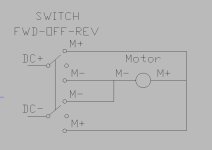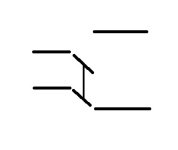Industrial Toys
Super Star Member
- Joined
- Feb 25, 2008
- Messages
- 16,742
- Location
- Ontario Canada
- Tractor
- Kubota R510 Wheel Loader + Cab and backhoe, JD 6200 Open Station, Cushman 6150, 4x4, ten foot 56 hp Kubota diesel hydraulic wing mower, Steiner 430 Diesel Max, Kawasaki Diesel Mule, JD 4x2 Electric Gator
Building a small Welding turntable for a friend with fractional HP, DC Motor and Drive.
I have built hundreds of DC Polarity Reversing circuits using a DPDT switch, but I have an industrial panel switch with three positions, and four contacts. Nothing is connected in the center position and the contacts are either in the other two positions. I was sure I could substitute this contact arrangement for my normal DPDT switch, but I can't make it work without getting an unintended short as I am trying to reverse the wires in one position.
Any ideas. I did not draw it out on account of laziness, but for the time I have spent on it, would have been well worth it.
I don't really need reversing, but I only had this more complex switch to go in an existing hole. So I thought, I would offer that feature to my friend.
ALSO. Is there any danger in disconnecting a DC motor from a DC motor control circuit. Ptentially, when there is still some residual power in the drive?
I have built hundreds of DC Polarity Reversing circuits using a DPDT switch, but I have an industrial panel switch with three positions, and four contacts. Nothing is connected in the center position and the contacts are either in the other two positions. I was sure I could substitute this contact arrangement for my normal DPDT switch, but I can't make it work without getting an unintended short as I am trying to reverse the wires in one position.
Any ideas. I did not draw it out on account of laziness, but for the time I have spent on it, would have been well worth it.
I don't really need reversing, but I only had this more complex switch to go in an existing hole. So I thought, I would offer that feature to my friend.
ALSO. Is there any danger in disconnecting a DC motor from a DC motor control circuit. Ptentially, when there is still some residual power in the drive?

